If you buy through our links, we may earn an affiliate commission. This supports our mission to get more people active and outside.Learn about Outside Online's affiliate link policy
The 5 Best Climbing Backpacks and Kitbags (Updated Fall 2025)

(Photo: Anthony Walsh)
Backpacks are like haircuts: everyone has one and someone else’s is always better. Both can serve all types of climbers, from casual craggers and gym-goers to fast-and-light alpinists and multi-day big-wallers. But unlike hair cuts, most of which are versatile enough to wear anywhere, each climbing backpack comes with a unique set of features—and is intended for a specific use case.
Climbing’s field-testing team has tested backpacks for decades, and, as a result, we know what makes for a worthy pack: comfort, durability, features, and weight all must be balanced against one another to arrive at an ideal design. Below are the painstakingly made backpacks that have struck such a balance. Some are new for 2025 and many are not. Together, they make for the best backpacks currently on the market.
Updated December 2025: We added two new packs to this guide; our new favorite for multi-pitching, Blue Ice’s Wadi 15L, and The North Face’s freakishly light alpine pack, the Advanced Mountain Kit 40L. We’ve also updated pricing as well as pack specs and info throughout.
The best climbing packs at a glance
- Best for Cragging: Black Diamond Creek 50L ($220)
- Best for Alpinism: Patagonia Ascensionist 35L ($229)
- Best for Multi-pitch: Blue Ice Wadi 15L ($100)
- Best for Multi-day Objectives: Osprey Mutant 52L ($230)
- Best for Travel: Rab Expedition II 80L Kitbag ($145)
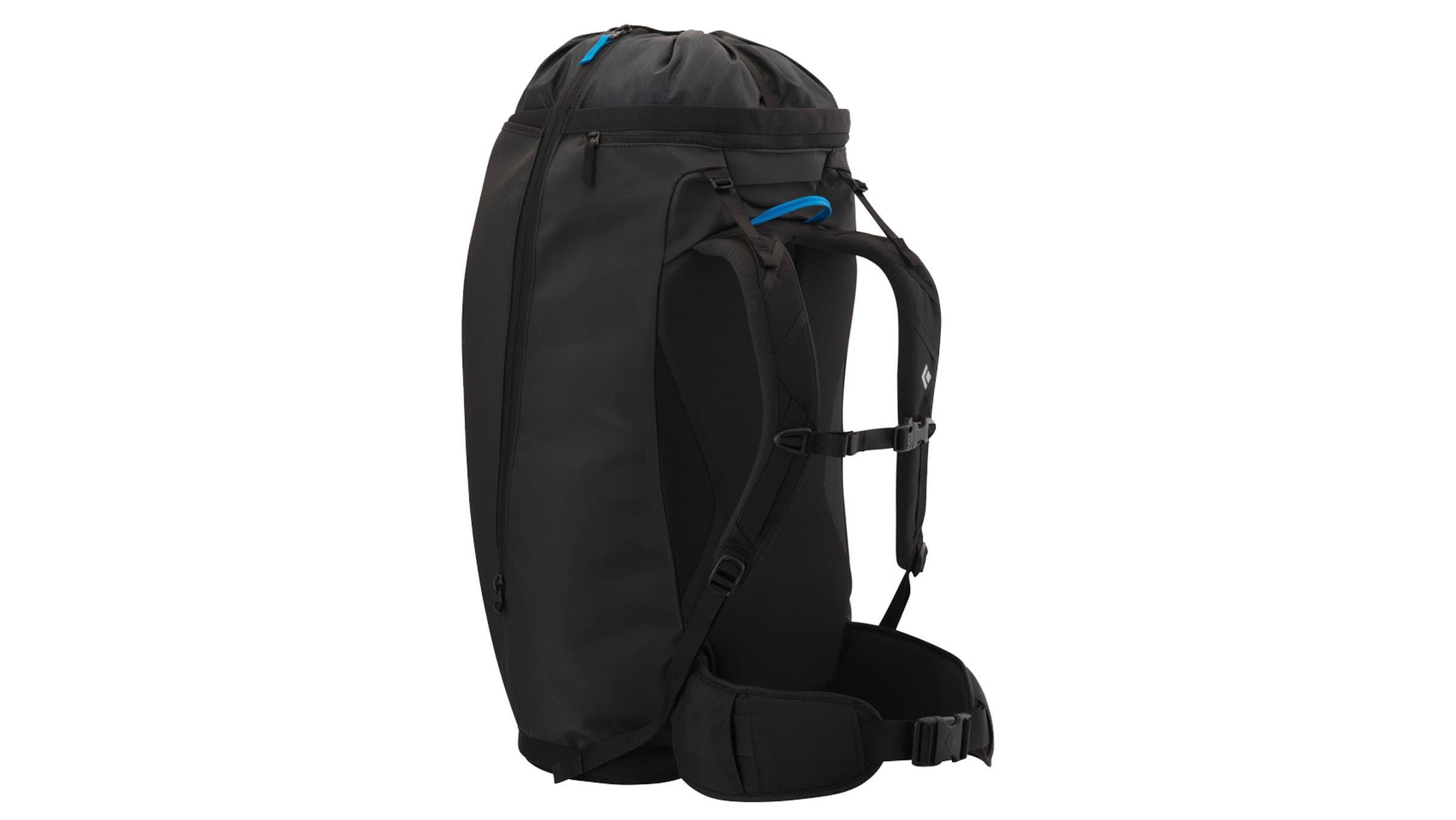
(Photo: Courtesy Black Diamond)
Best for cragging
Black Diamond Creek 50L
$240 at Black Diamond
Weight: 4.4 lbs (S–M)
Volume: 50L (S–M)
Size: S–M, M–L (unisex)
Pros and Cons
⊕ Comfortable carry
⊕ Many organizer pockets
⊕ Full side-zip
⊗ Quite heavy
Rock up to any busy North American crag and we’ll all but guarantee there’s a Creek 50 or two parked at its base. There’s good reason: BD’s flagship cragging pack is built to last, and its thoughtfully placed pockets will spare you the yard sale beneath the proj.
Our testers agreed that 50 liters is the ideal volume for cragging, no matter where or what you’re climbing. We easily stuffed it with a double rack of cams, 60-meter rope, water, helmet, and personal gear while jamming impeccable Squamish granite last summer. When the mercury dropped and we migrated to the sharp crimps of Smith Rock, Oregon, the Creek 50 just as easily carried two dozen draws, a belay parka and pants, and endless liters of tea.
The Creek 50 has a wide, top-loading opening and a full-length side zip, which makes packing and unpacking a breeze. The thickly padded hip belt and shoulder straps, plus rigid internal stays, carried 30 pounds of gear with ease, and a hooked rope strap lets you lash even more kit on top. The Creek 50’s burly, haul-bag inspired design—comprised of watertight Ballistic Nylon—has held up well to rough belay zones and brief sections of hauling. It is far from the lightest pack around, but for cragging, where weight is rarely an issue, the Creek 50 is hard to beat. We can’t wait to use it again this spring.
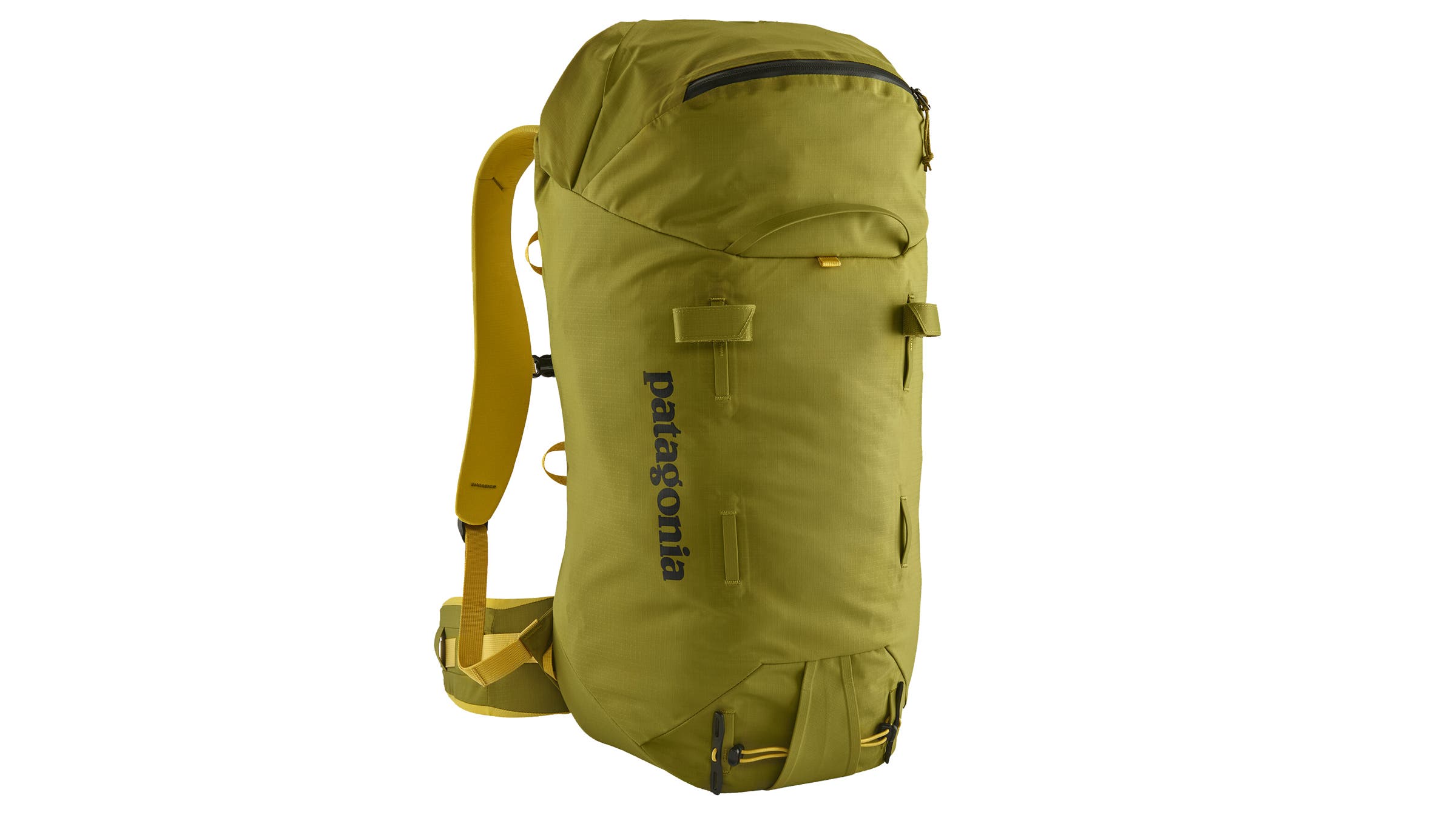
(Photo: Courtesy Patagonia)
Best for alpinism
Patagonia Ascensionist 35L
Weight: 1.8 lbs
Volume: 35L, 55L
Size: S, M, L (unisex)
Pros and Cons
⊕ Highly customizable
⊕ Supportive, balanced carry
⊕ Smart pocket design
⊗ No weather protection when pack is over-filled
The newly updated Ascensionist pack may not be one of the cool white Dyneema backpacks that seem to grace most alpinists’ shoulders these days, but make no mistake: Patagonia’s 2025 model is a veritable beast in the alpine, with an impressively modular design, easy-to-use features, and a surprisingly low weight (1.8 pounds fully loaded; 1.2 pounds stripped.)
Emilie Grenier, a Climbing contributor and experienced all-arounder, tested the Ascensionist 35L during a day of glaciated mountaineering in the Canadian Rockies. “The pack is surprisingly feature-heavy despite its light weight,” Grenier noted. “It’s not often that you get a sub-1.3-pound alpine pack that also comes with load-lifter straps.”
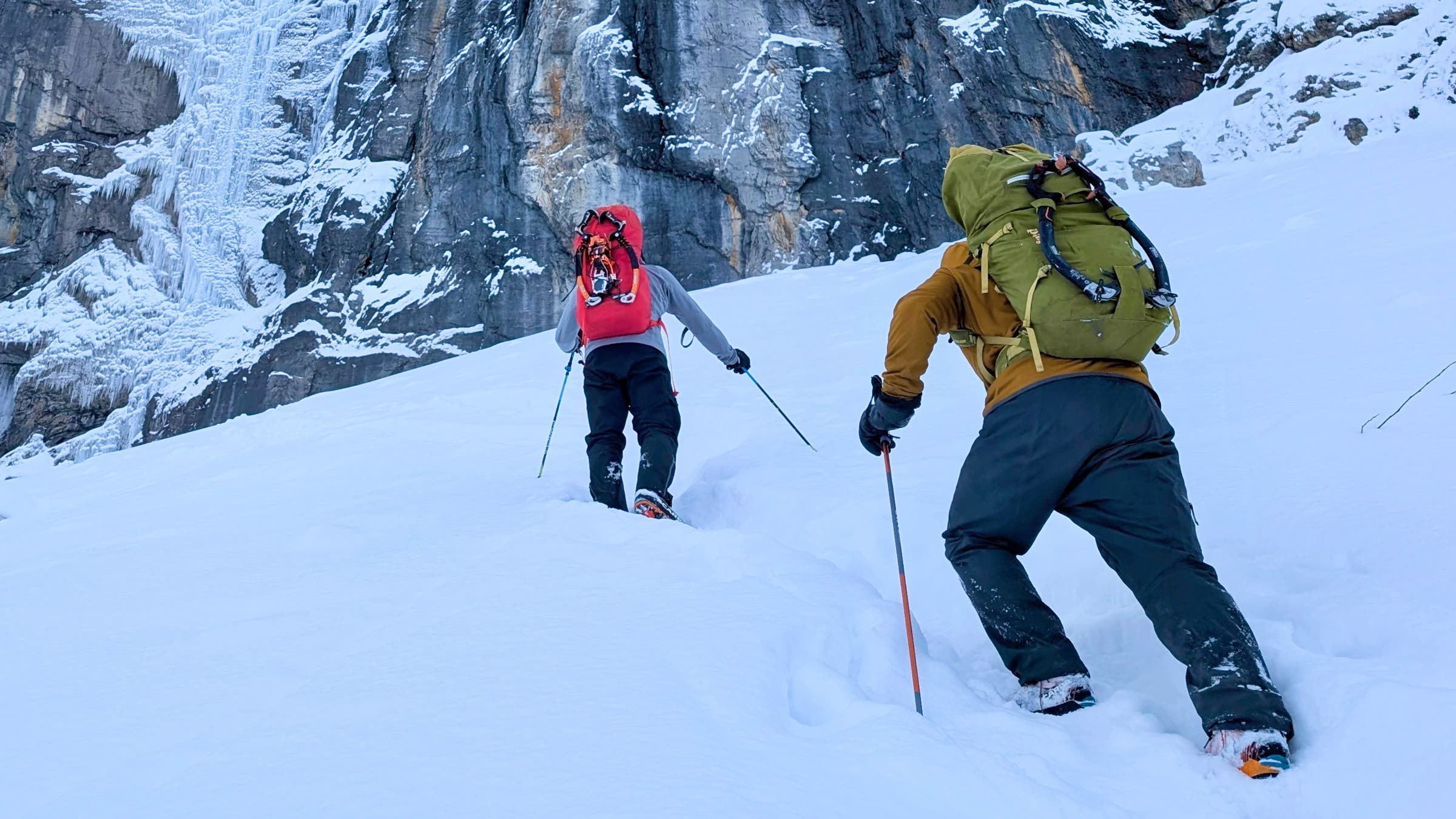
The Ascensionist has two integrated hipbelt options (one-inch webbing or thick, foam padding, both removable), four compression straps, two ice-tool attachments, two zipped pockets (both of which are surprisingly easy to access even when the pack is full), a rope strap, a foam backpanel, and two sturdy haul loops. Testers were also quick to note that the underside of the pack’s shoulder straps—typically the first failure point on many packs—were reinforced with a thick strip of webbing. The rest of the pack is made of an equally burly and recycled 210-denier nylon ripstop, which is finished with a TPU coating.
The Ascensionist is a nearly perfect pack, but its top closure leaves room for design improvement. The Ascensionist’s storm collar repels rain and spindrift when it’s under capacity; but when I stuffed 38 liters of kit into it for an attempt of a 600-meter M6+ alpine wall in Banff National Park, the top sprouted a large opening for ice and snow to fall into. Thankfully the Ascensionist also comes in a 55-liter size.
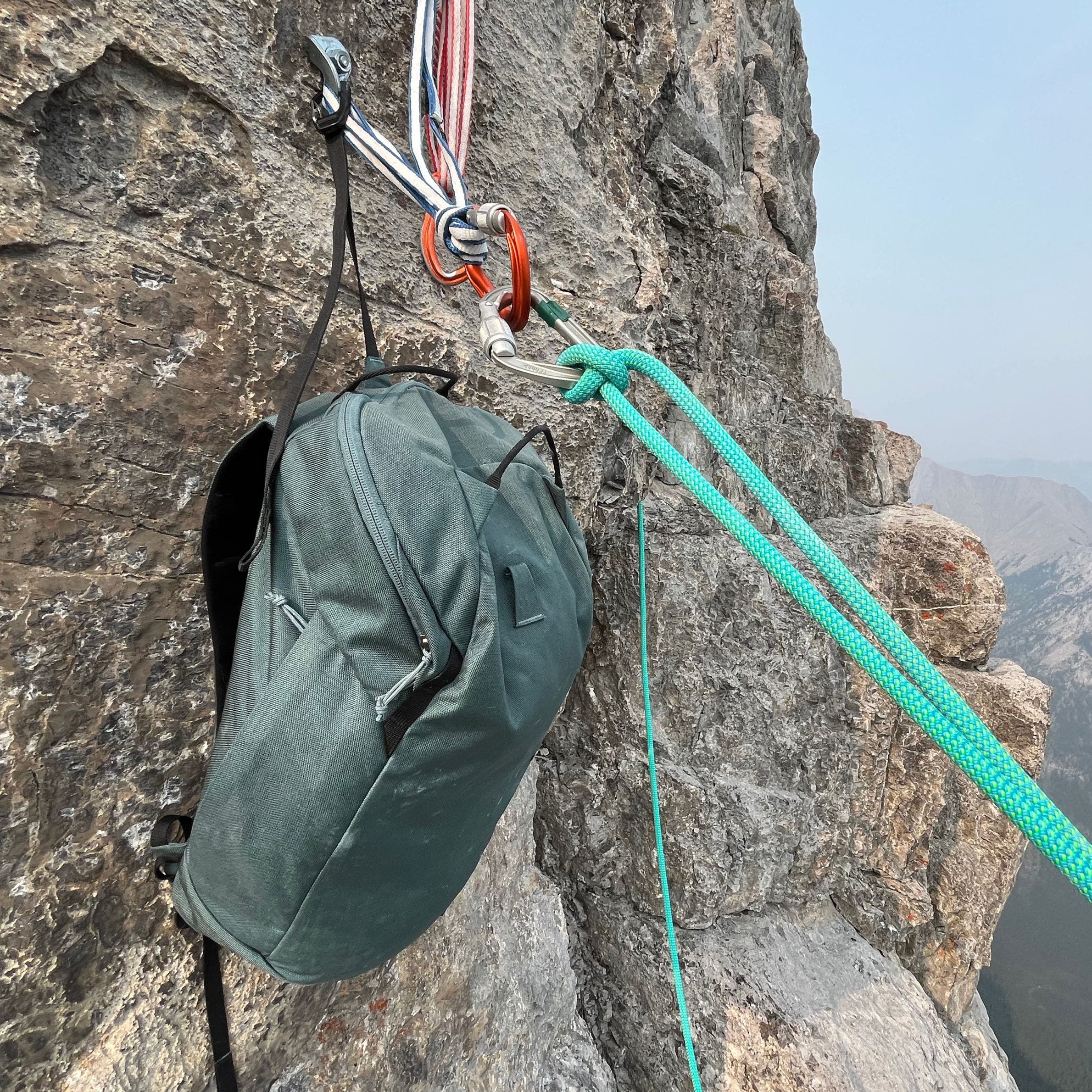
Best for multi-pitch
Blue Ice Wadi 15L
Weight: 1.1 lbs
Volume: 15L
Size: One size (unisex)
Pros and Cons
⊕ Feature-packed
⊕ Highly abrasion resistant
⊕ Easy to secure the pack at belays
⊗ Not particularly weather resistant
Blue Ice’s Wadi 15 pack is a feature-packed multi-pitch weapon, fit for long rock routes in Squamish and Red Rock, or “short” routes in Yosemite. The pack’s simple, durable design left testers supported and satisfied after a long day on the wall: a helmet and trekking pokes can be easily stashed on the outside of the pack, while a low-profile 0.8-inch webbing hip belt ensures the pack stays balanced on the approach and during overhanging cruxes (all three features are easily removable).
The Wadi has a fixed foam back panel, with extra padding around the thoracic spine, and an ingenious adjustable rope-carry strap that doubles as the pack’s tether for clipping in to exposed belay stations. The rope strap comes with a wire-gate carabiner (rated to 2kN) and was greatly appreciated while climbing the Gmoser Route (5.9; 15p) on Mount Louis, Banff, last summer. On a long route like Gmoser, hydrating and re-fueling regularly ensures you don’t bonk by the summit. Thanks to the Wadi’s adjustable tether, my snacks were always quickly accessible no matter the belay stance.
Made with a super-tough 1000-denier high tenacity nylon 6,6, the Wadi is extremely durable and can confidently be hauled through cruxes. While we wouldn’t want the Wadi to be our daily-driver haul bag, it is plenty durable for occasional use. Tough as it is, the fabric is not magic, and it’s unfortunately not waterproof or particularly weather resistant. Save the Wadi for fair-weather rock climbing, and sub in Blue Ice’s Dragonfly 18 for when precip is in the forecast.
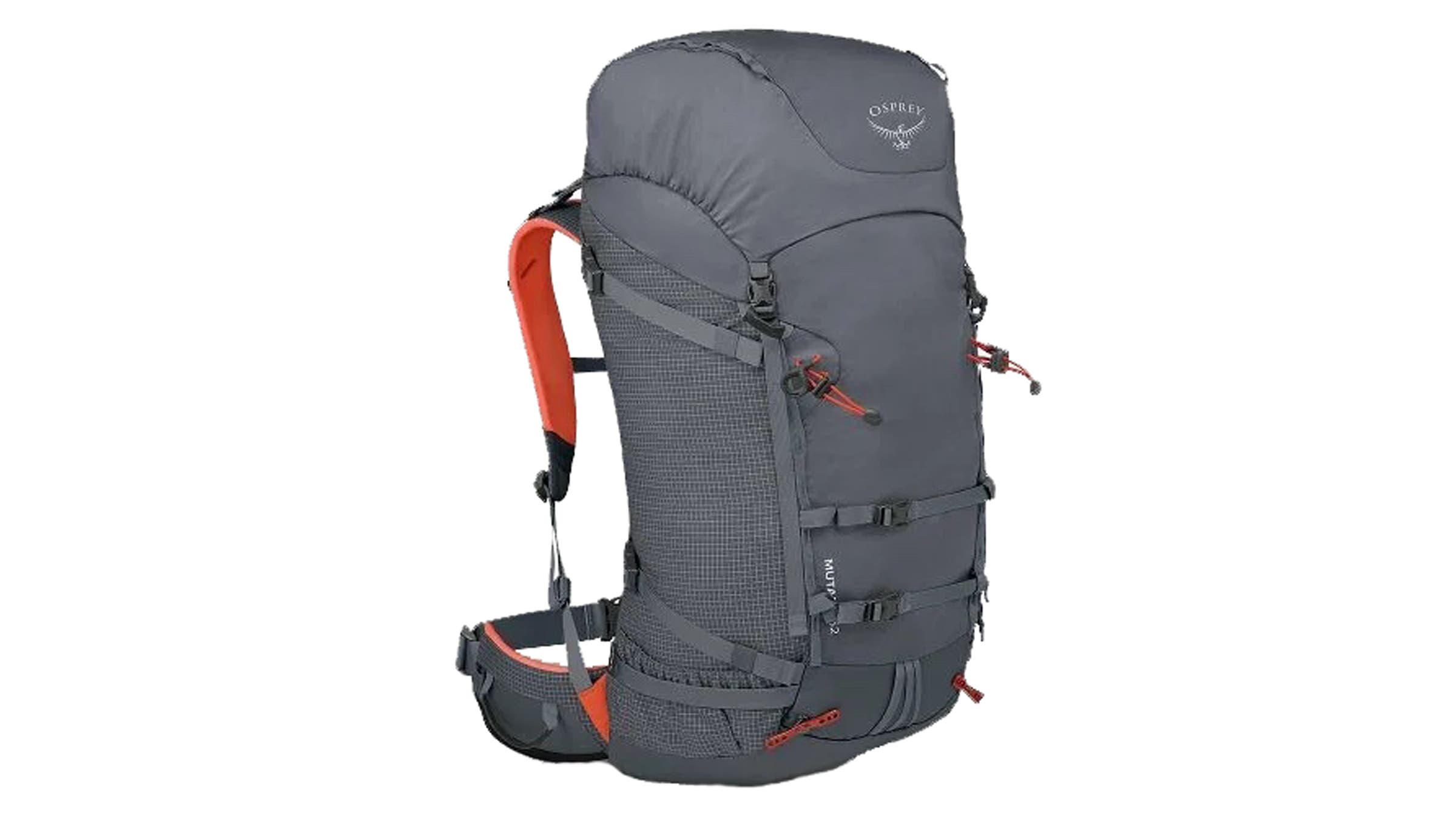
(Photo: Courtesy Osprey)
Best for multi-day
Osprey Mutant 52
Weight: 3.4 lbs
Volume: 38L, 52L
Size: S–M, M–L (unisex)
Pros and Cons
⊕ Affordable
⊕ Works for summer or winter climbing
⊕ Amazing warranty policy
⊗ Not the lightest pack around
We’ve been using versions of Osprey’s Mutant series for nearly 10 years and can’t think of a better bargain than the 52L pack. Whether you’re trekking into the Wind River Range for a multi-day rock-climbing trip or attempting the White Mountains’ Presidential Traverse in winter, the Mutant 52 L has all the features you need to do so in comfort and style—though you probably won’t be breaking any speed records with a pack this weighty.
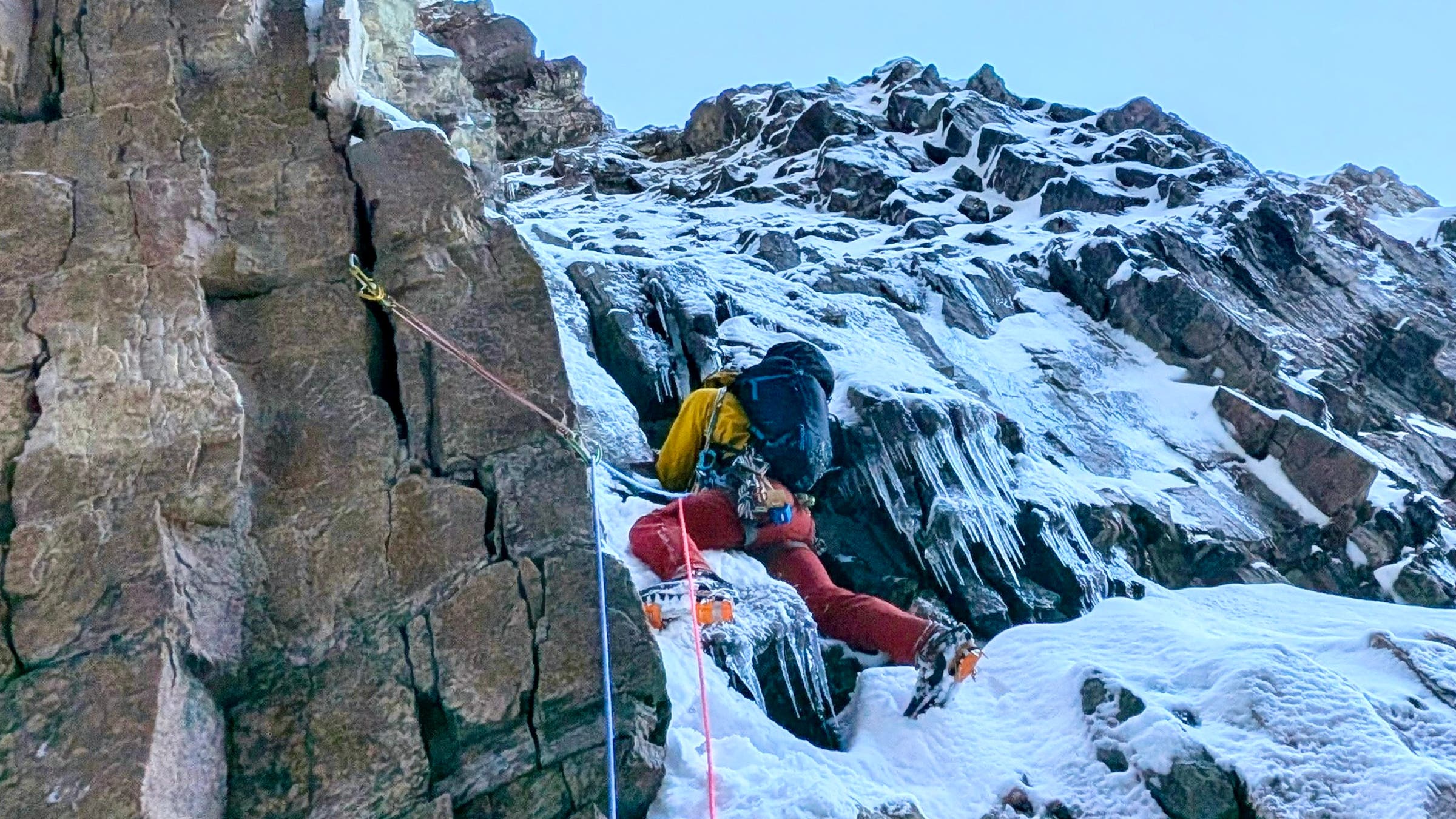
I appreciated the Mutant’s modularity while testing it on the Snowpatch Route (5.8; 450m) in the Bugaboos. The pack’s compression straps, crampon attachment, and external daisy chain let me load this pack up for four days of camping in the alpine. Fully loaded with all that gear, the pack weighed roughly 40 pounds but handled the multi-hour approach with ease, thanks to a padded hipbelt, load lifter straps, and a stiff back panel framed by dual aluminum stays. When it came time for the technical climbing, I was able to quickly strip away the straps and the lid to save weight.
Perhaps the most impressive thing about the Mutant, however, is Osprey’s commitment to it. The brand’s “All Mighty Guarantee” promises to repair or replace any torn, broken, or otherwise destroyed part of the pack—regardless of when the pack was first made or whether you still have a receipt for it. Though the Mutant pack is indeed durable, due to pack rats, rock fall, and mishandling over the years, we’ve had to cash in on this promise several times and can confirm the hype.
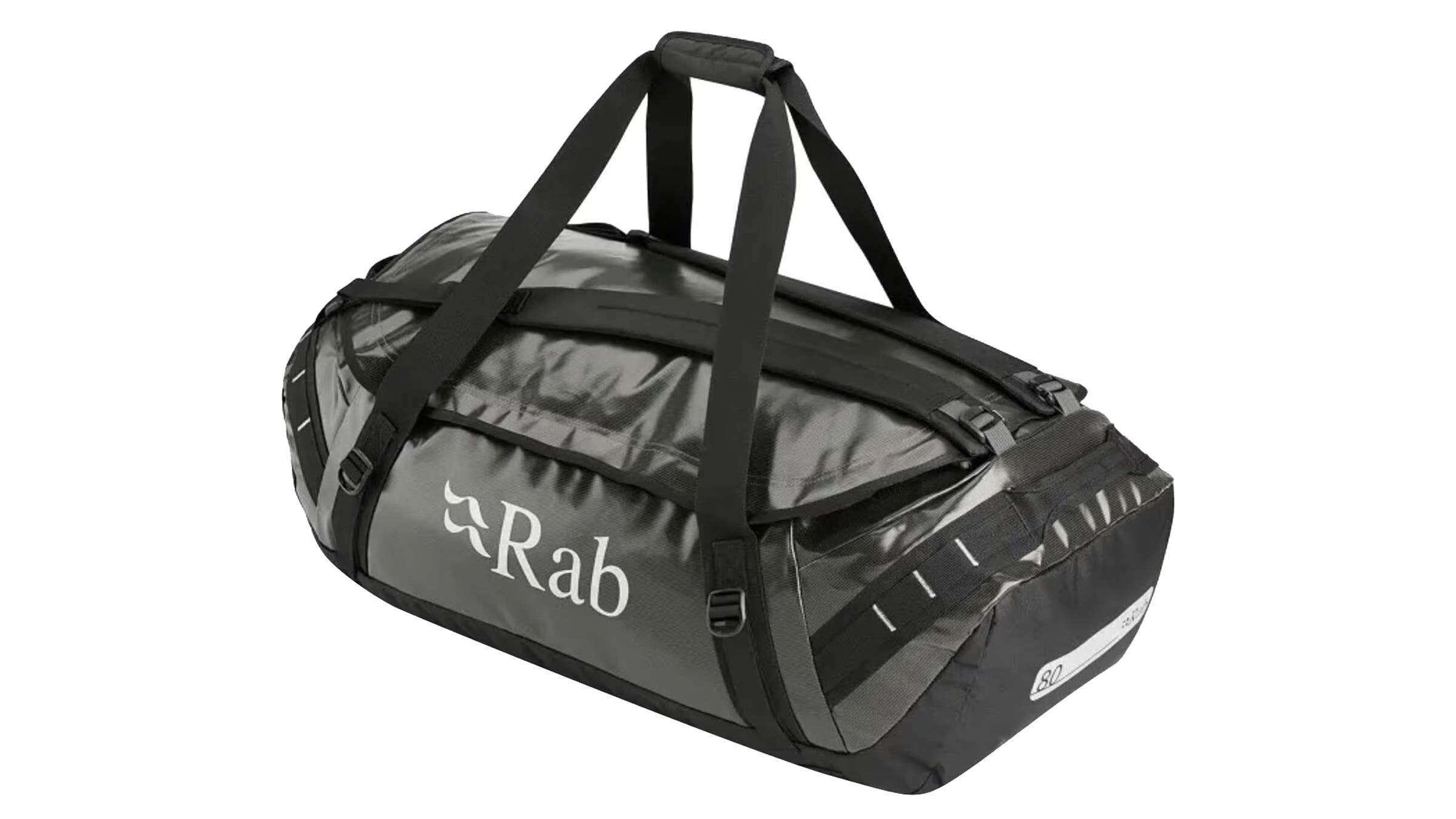
(Photo: Courtesy Rab)
Best for travel
Rab Expedition II Kitbag 80L
$145 at Rab
Weight: 2.4 lbs
Volume: 80L
Size: One size (unisex)
Pros and Cons
⊕ Detachable shoulder straps
⊕ Extremely durable
⊕ Lockable luggage-zip
⊗ Durability comes with a hefty weight penalty
Have a long travel sequence on the horizon? While you could stuff all your climbing gear into a backpack and pray the baggage handler plays nicely with its plastic buckles, we recommend a purpose-built duffle bag instead.
Rab’s Expedition II Kitbag is about as burly as they come, with a rubbery, TPU-coated 600-denier external fabric, double-thick polyester base fabric, and triple-stitched seams. The Kitbag is designed for both air and land travel: daisy chain lash points help you secure it to the top of a truck (or donkey), a lockable luggage-zip keeps your belongings secure when the bag is out of sight, and detachable shoulder straps help you cart it around when no trollies are available. That said, the Kitbag will be needlessly burly for some excursions—you probably don’t need it for a direct flight to Europe—and it’s worth noting its 2.2 pounds will quickly eat into most airlines’ 50-pound weight limit.
We brought the Kitbag on a multi-day journey down to Argentine Patagonia last December, and found two 80-liter duffles to be an ideal volume for a month’s worth of alpine-climbing gear. The Kitbag’s two internal pockets helped us stay organized (and find our books) during a 10-hour layover in the Santiago airport, and its three sets of handles let us load the duffle into taxis, buses, bag checks, and onto our shoulders while we marched the final mile from El Chaltén’s bus station to our hostel. Impressively, our testers noted zero signs of wear.
The 80L Kitbag is already a steal at $120, but for just $10 more you can upgrade to a 120L and ferry gear across the globe to your heart’s content.
Other climbing backpacks we like
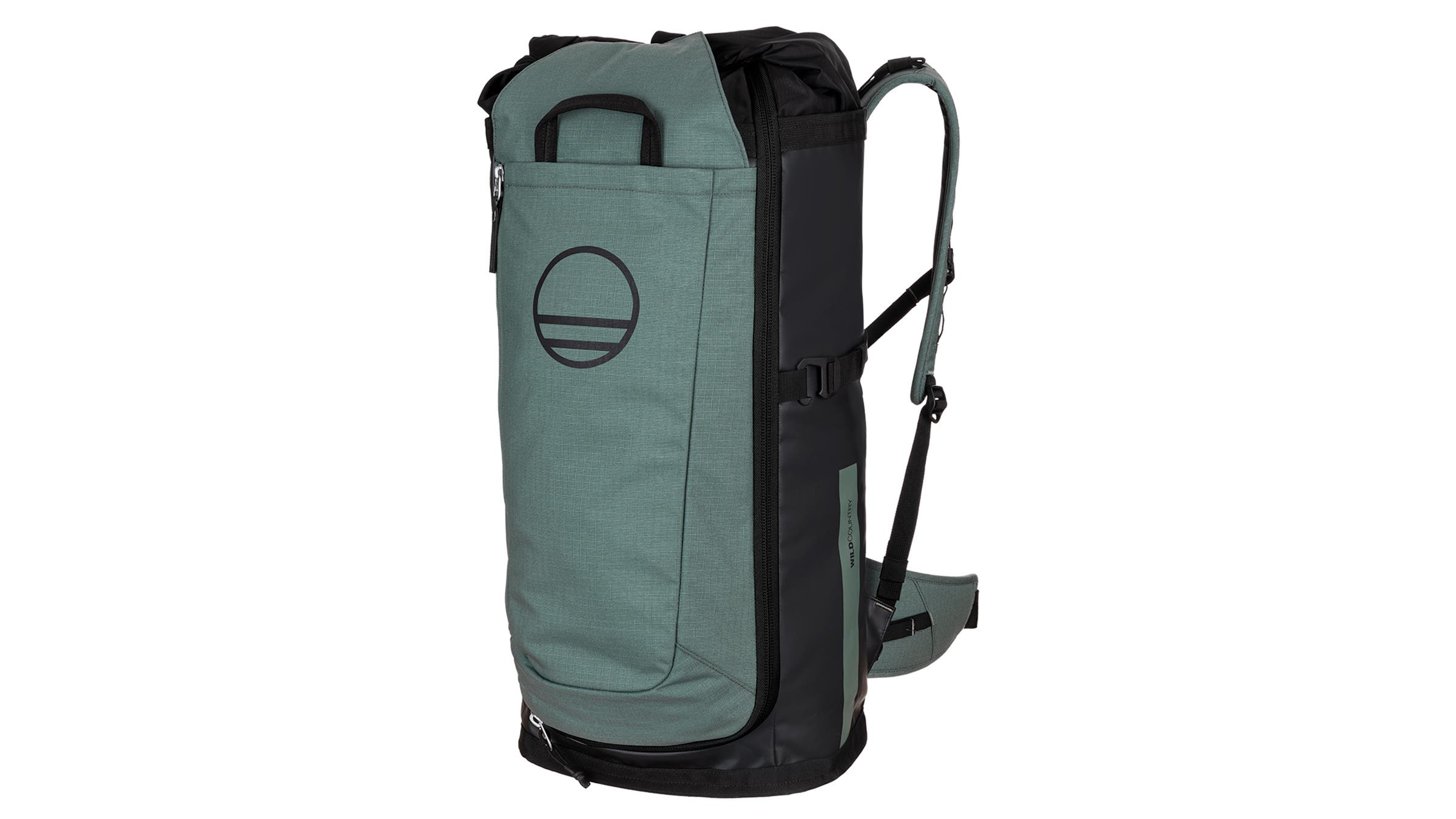
(Photo: Courtesy Wild Country)
Wild Country Crag Hauler 40L
Weight: 3.5 lbs
Volume: 40L
Size: Unisex; one size
Pros and Cons
⊕ Comfortable under heavy loads
⊕ Can be unzipped to create a crag mat
⊗ Feels small for 40L
Wild Country’s Crag Hauler comes in a close second place for our favorite cragging pack thanks to its burly design, comfortable carry, and wrap-around side zip that lets you use the pack like a mat at dusty crags.
Our testers, led by former Climbing digital editor Steve Potter, loaded this pack up for long cragging days in New Mexico’s Diablo Canyon, Kentucky’s Red River Gorge, and Siurana, Catalonia. Potter was immediately impressed with the Crag Hauler’s suspension system—a smart combo of load-lifting straps and carefully rationed foam: “The shoulder straps and waist belt are ideally padded for the pack’s volume—not too cushy, but certainly not minimal.” Potter, who is 5’8″ but has “a stubby gnome’s torso,” also thought the pack’s backpanel fit him well. Unfortunately, the Crag Hauler 40 only comes in one size—so if you don’t share Potter’s physical attributes, it may not fit you as well.
I schlepped dozens of draws and an 80-meter rope around the Red with the Crag Hauler and loved its ability to act as a tarp while climbing at dusty sandstone crags. One ding: It feels small for its stated 40 liters, and I was relieved to not also be packing a trad rack for the trip. The pack won’t fit carry draws, rope, and a rack internally, and we wish Wild Country had created an identical 50-liter version.
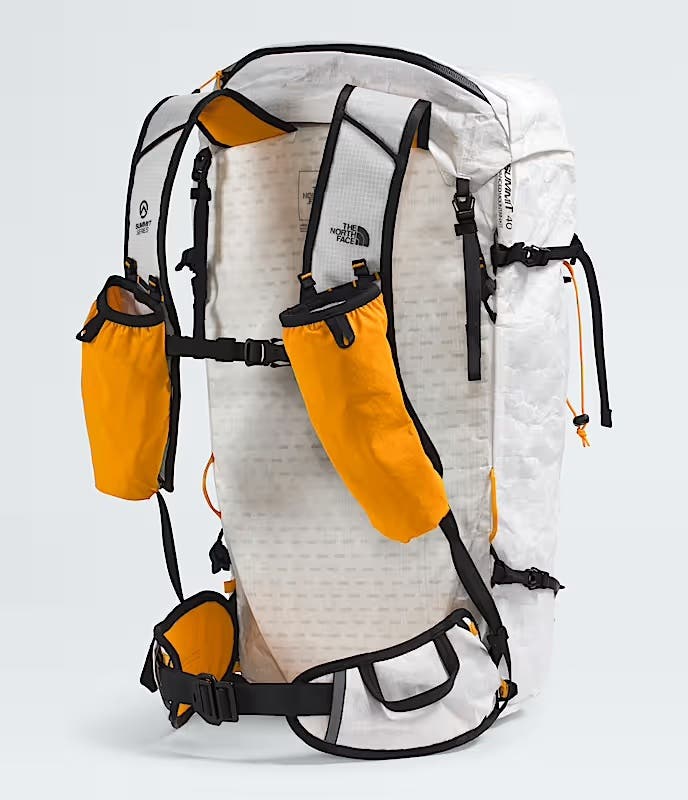
The North Face Summit Series Advanced Mountain Kit 40L
Weight: 1.8 lbs (S/M)
Volume: 40L
Size:S/M, M/L
Pros and Cons
⊕ Incredibly modular design
⊕ Super light when stripped
⊕ Clever pocket design on shoulder straps
⊗ Skinny nylon webbing makes shoulder straps annoying to put on
⊗ Removable hip belt can migrate and undo itself
There is a lot going on with The North Face’s all-new Summit Series Advanced Mountain Kit (AMK) pack, and we do not mean that as an insult. When fully equipped, the AMK, made from 120D Dyneema ripstop, comes with: four compression straps, two pairs of ice-tool attachments, a zippered lid, perforated foam back panel, padded hip belt, and two water-bottle sized pockets on the shoulder straps. All of this is easily removable, and cuts the pack’s weight from 1.8 lbs to just 0.8 lbs.
While testing on multi-hour approaches in the Canadian Rockies, and later throughout the Swiss Alps in mixed conditions, I loved the versatility the pack provided. When packed to the hilt with bivy gear, the lid helped me stay organized when searching for essentials like food, sun glasses, and lip balm, and the padded hip belt helped disperse some of the extra load. On less gear-intensive days, I stripped nearly everything away for a clean, lightweight carry that let me climb through squeeze chimneys and ‘shwack through thick alder without anything for the pack to snag on. In both scenarios I used the AMK pack’s ingenious shoulder-strap pockets; one carried a 500mL soft flask of water while the other carried my phone and snacks. I’d quickly remove the pockets when starting up a route to avoid snagging and tearing them, and easily reattached them for the descent.
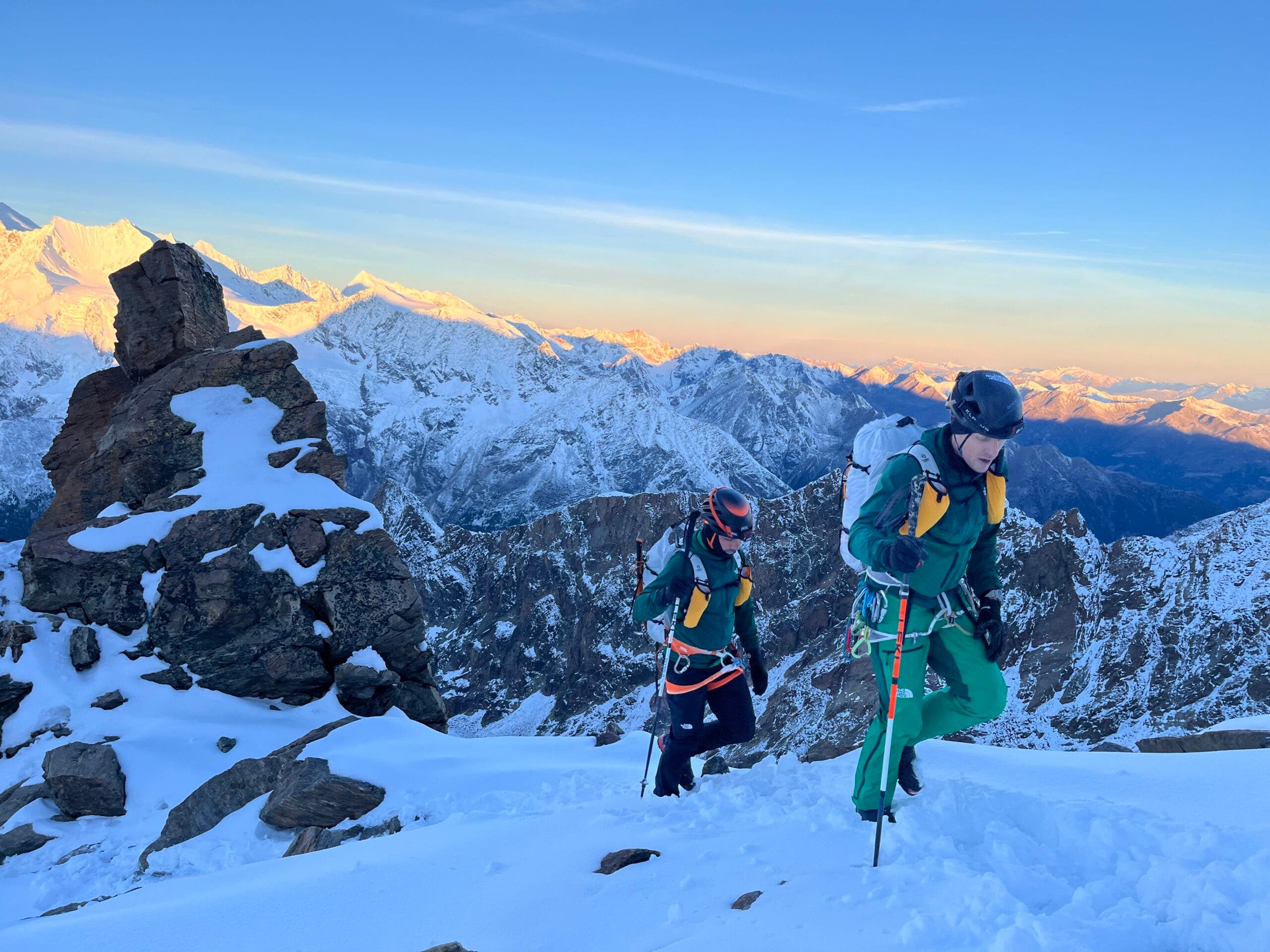
On the quest for a ridiculously light pack, climbers should expect some downsides in usability, and the AMK pack is no exception. Its padded hip belt is secured to the bag’s chassis on only one end, leading to belt migration and discomfort. And the nylon webbing which connects the padded shoulder strap to the pack is frustratingly narrow; when shrugging on the pack—and especially if carrying something in the exterior pocket—the shoulder strap will twist in barrel rolls since the webbing isn’t wide or stiff enough to combat the torsion.
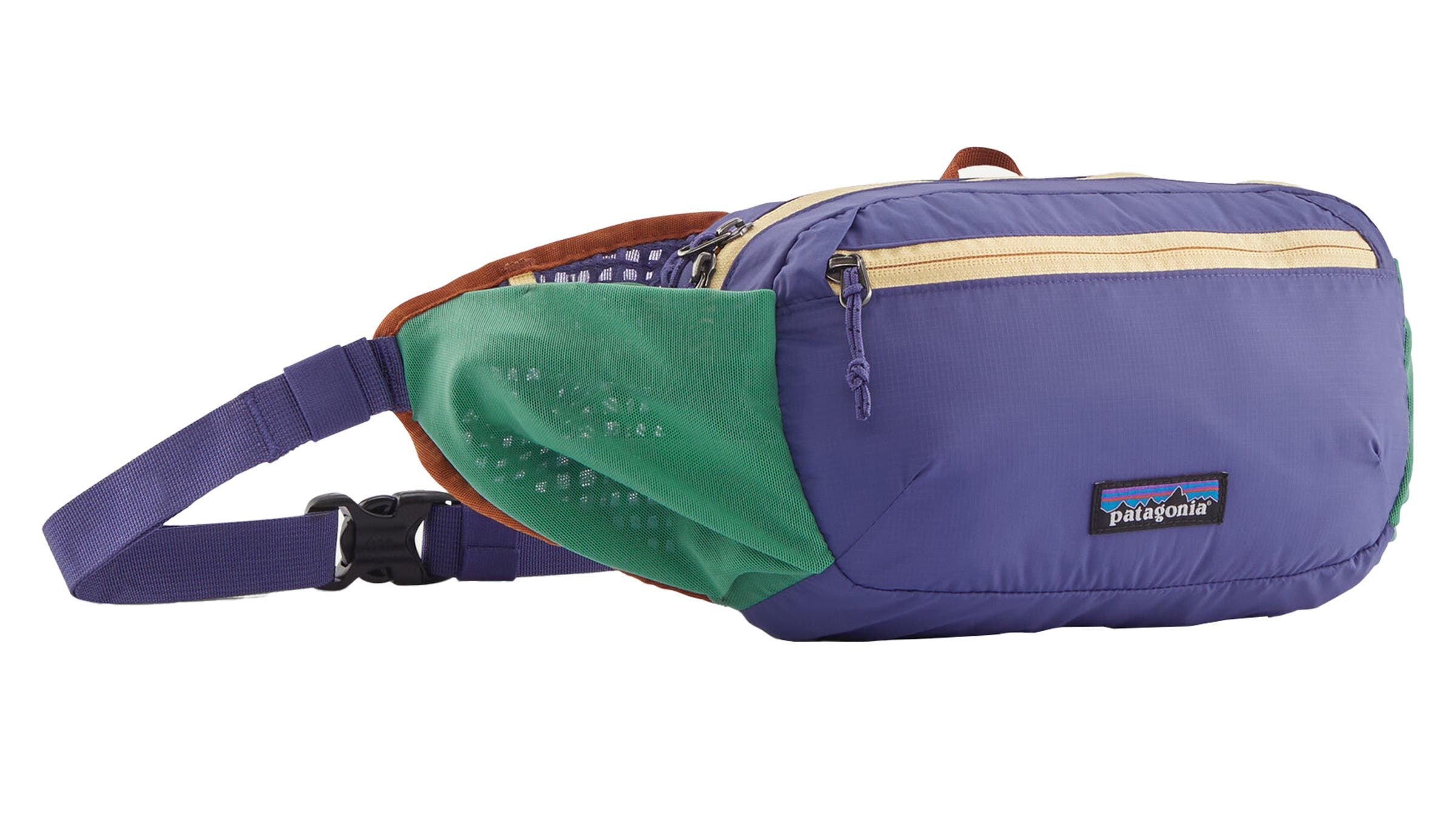
(Photo: Courtesy Patagonia)
Patagonia Terravia Hip Pack
Weight: 6.4 oz
Volume: 5L
Size: One size (unisex)
Pros and Cons
⊕ Low-profile design
⊕ Plentiful organization
⊕ Minimal bounce on fast-paced approaches and descents
⊗ Exterior mesh pockets are prone to snagging
“Fanny packs” have gotten a clever rebranding into “hip packs” lately, and we are so here for it. The design is simple, inherently airy, and holds everything you need (wind jacket, liter of water, calories, headlamp, cell phone) for a day of warm-weather multi-pitch climbing.
The Terravia Hip Pack is technically designed for hikers, but its durable, form-hugging design has carried well up Squamish’s Stawamus Chief and throughout Red Rock Canyon for quick multi-pitch hits where a backpack felt like overkill—and in some cases would have hindered our ability to climb through chimneys. (Last pitch of Angel’s Crest, anyone?)
Made from DWR-treated recycled nylon, the Terravia Hip Pack is moderately weather-resistant and highly packable. It has a number of organizational compartments despite its small size, including two mesh drop pockets within the main compartment, a zippered front pocket, two external water-bottle pockets (unfortunately prone to snagging), and a key clip.
Our favorite part of testing the Terravia has surely been the gobsmacked climbers we’ve passed while multi-pitching. You’re wearing a fanny pack? Why didn’t I think of that!
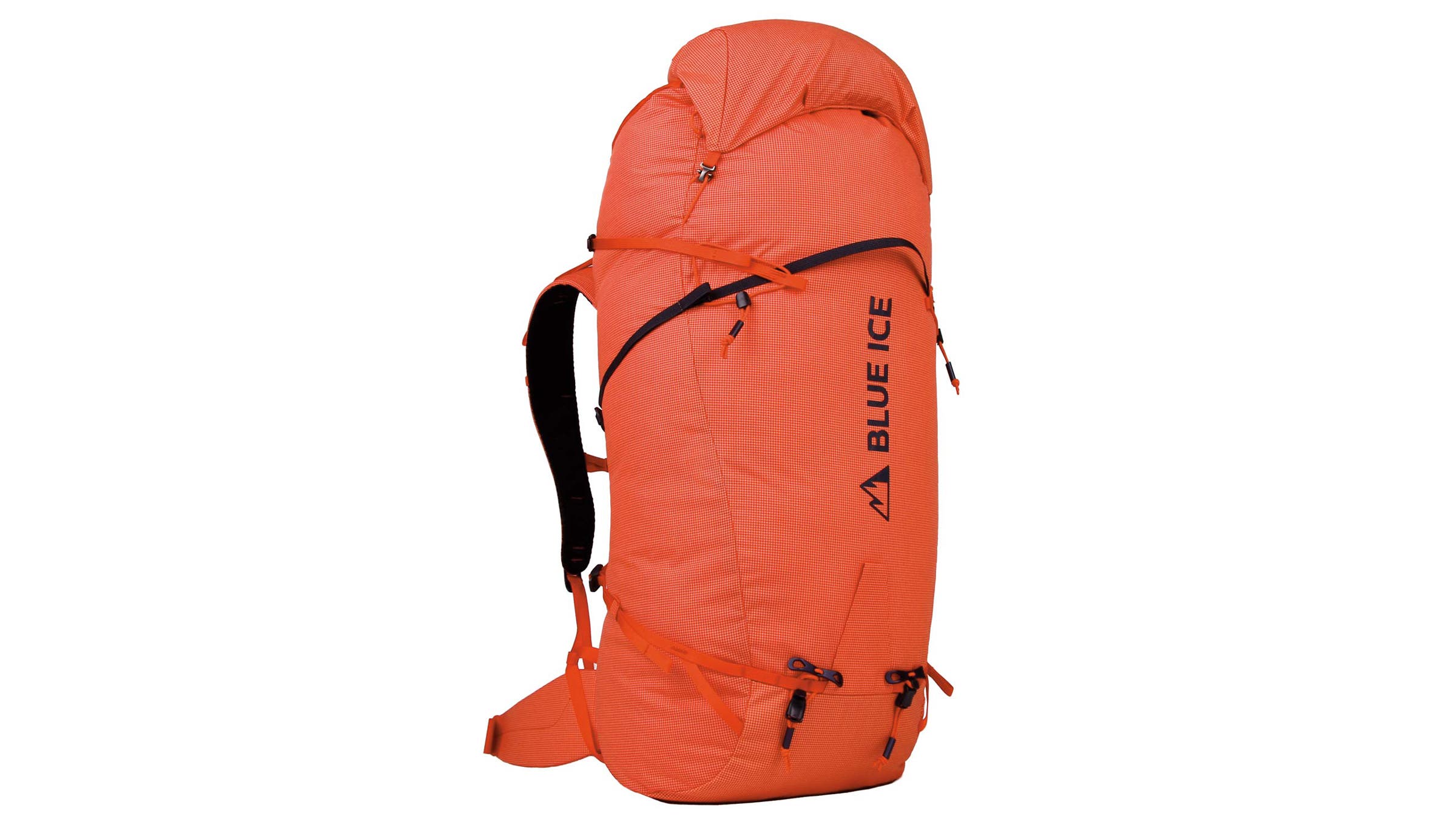
(Photo: Courtesy Blue Ice)
Blue Ice Stache 60 L
$260 at Blue Ice
Weight: 1.8 lbs
Volume: 60L, 90L
Size: One size (unisex)
Pros and Cons
⊕ Extremely lightweight
⊕ Minimalist design is surprisingly comfortable
⊗ Tall frame limits head movement
⊗ Not extremely durable
Blue Ice is known for its gram-shaving equipment, and the Stache 60 L is no exception. With a verified—though still unbelievable—minimum weight of just 1.3 pounds, this pack might just be the lightest 60-liter pack we’ve ever used. Despite the featherweight design, the Stache 60 does have some engineering heft behind it, including six compression straps, two ice-tool attachments, an internal zipped pocket, and a removable lid.
While carrying overnight gear for six hours into Patagonia’s Chaltén massif last year, tester and experienced alpinist Jason Tuck was impressed by the Stache’s ability to handle such heavy loads. “The Stache looks about as supportive as a day bag when empty, but aluminum stays, a stiff foam backpanel, and the webbing compression bands did surprisingly good work at dispersing a big load,” he noted.
Tuck went on to make an ascent of the Supercanaleta (WI 4 M5; 1,600m) on Cerro Chaltén/Fitz Roy with the Stache and reported that the pack came back with several holes in the 210-denier robic nylon ripstop external fabric. Other testers reported that, after a season of use, the aluminum stays have also begun to wear through the bottom of the pack.
I used the Stache throughout the Bugaboos, Canadian Rockies, and Patagonia, primarily testing the pack on loose, wintry faces. While you can’t beat the weight, I found the backpanel to be too tall compared to other 60-liter offerings, which limited my head mobility when wearing a helmet. (I’m 5’10” with an 18″ torso.) Removing the aluminum stays and foam backpanel addressed this problem, but introduced another: limited support.
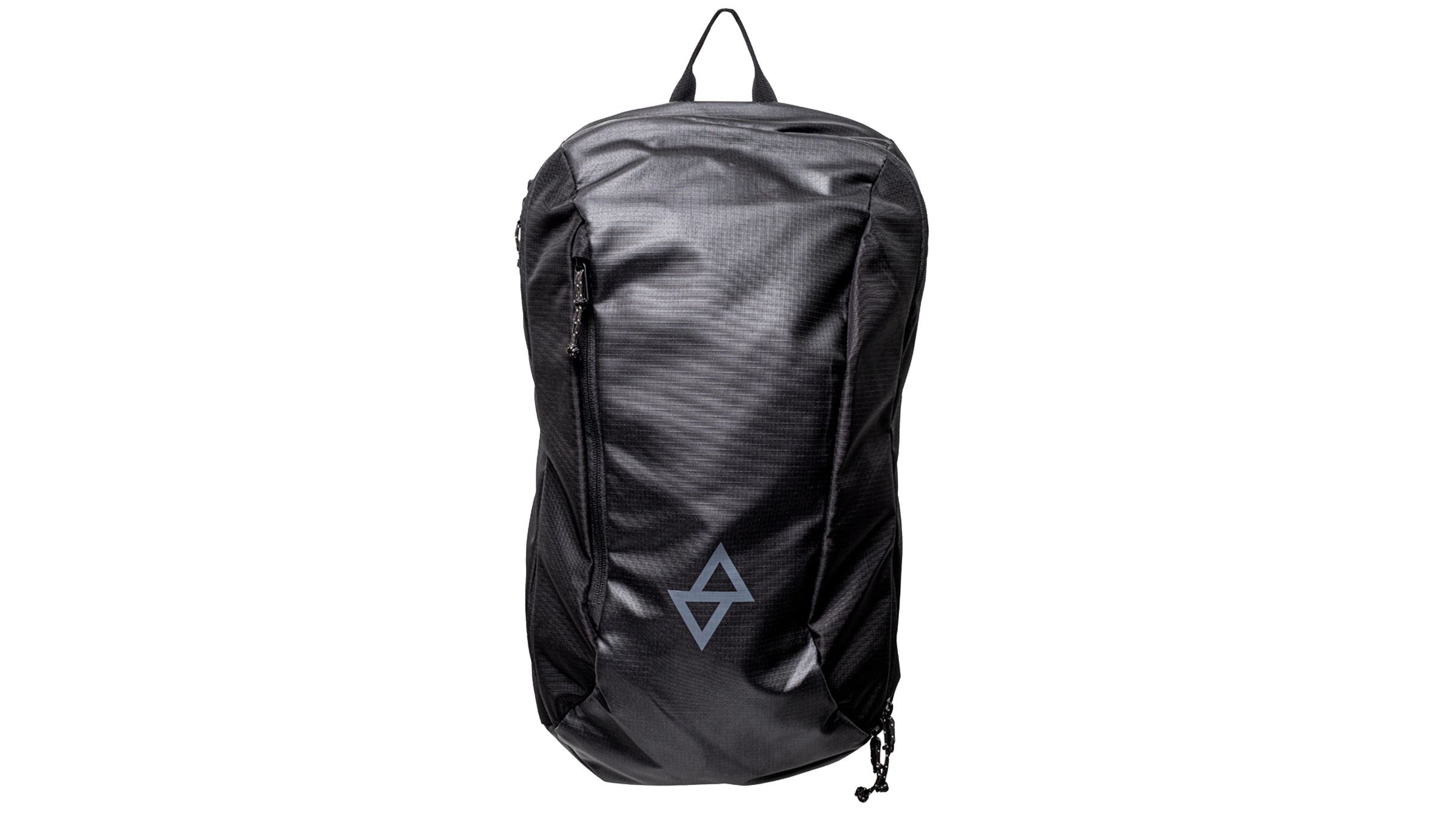
(Photo: Courtesy Sterling)
Sterling Bartleby Gym Bag
Weight: 1.5 lbs
Volume: 28L
Size: One size (unisex)
Pros and Cons
⊕ Perfect size and features for office-to-gym goers
⊕ A gym bag that doesn’t look like a gym bag
⊗ No way to externally attach belongings
Though I’m primarily an outdoor climber, I was surprised by how frequently I reached for the sleek, desk-jockey stylings of the Bartleby Gym Bag. It holds everything a desk-bound worker like myself needs, including laptop, keyboard, headphones, books, lunch, water, and coffee, and it still has room for a chalk bucket and a few pairs of gym shoes.
The 28-liter Bartleby has a convenient 180-degree clamshell opening that gives easy access to items in the bottom of the pack, a zipped stinky shoe pocket within the main body, a padded laptop sleeve, a key clip, and multiple interior and exterior pockets to stay organized.
What I most appreciated about the Bartleby is that, despite its many pockets, it’s not the pack version of a pair of cargo pants. Yes, you can schlepp a ton of office and gym supplies in it, but the glossy black outer and turtle-shell cut look at home in a professional setting too. I just wish there was an external strap or two to clip extra belongings (like shoes after a long session) to the outside so they didn’t mix in with my work clothes.
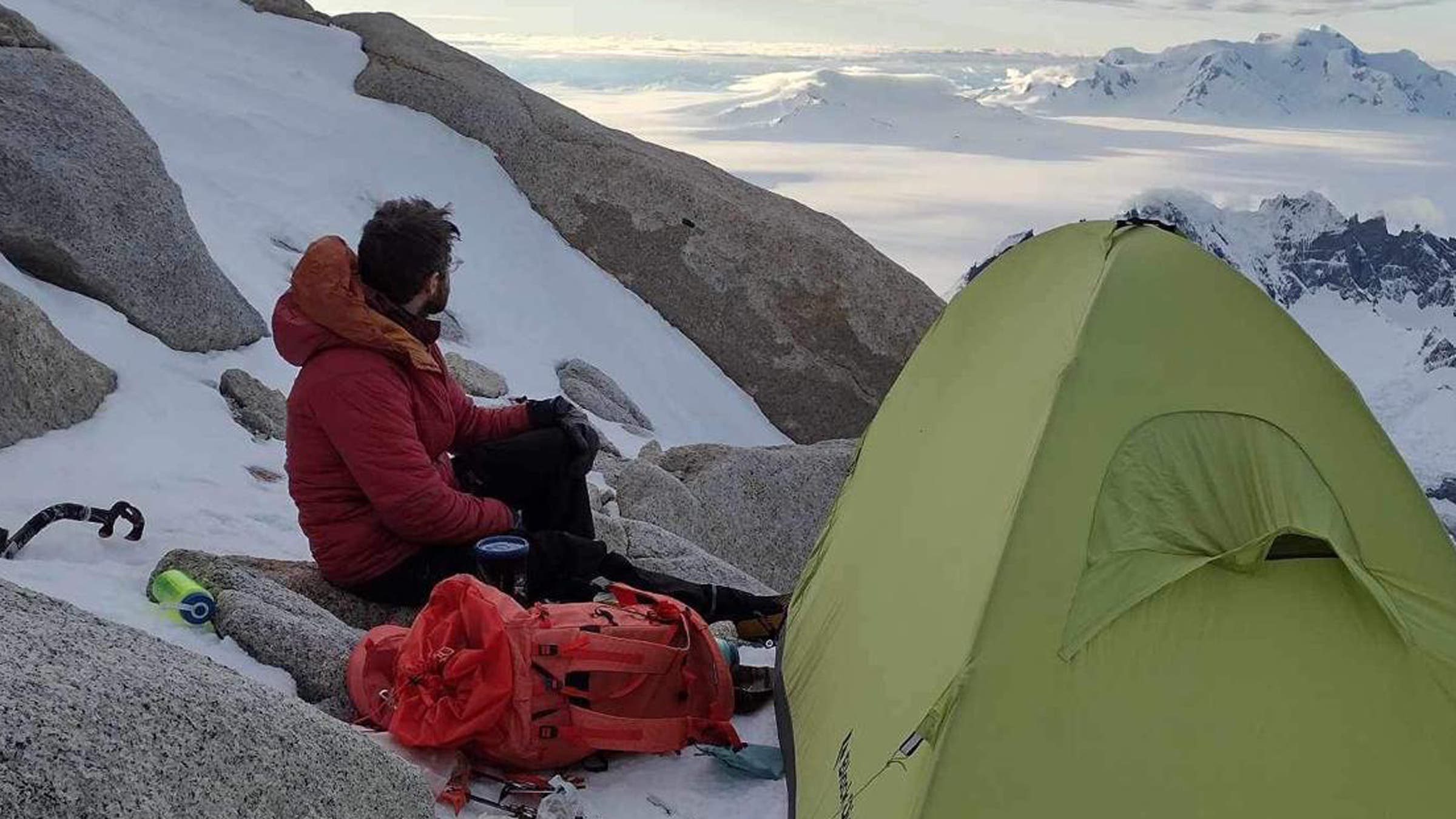
Just below the summit of Fitz Roy, Patagonia, with Blue Ice’s Stache 60L pack. (Photo: Jason Tuck)
How to choose a climbing pack
When choosing the optimal climbing pack, first think about the type of objectives you plan to tackle with it. If the approach to your sport project is 20 feet and you want to carry your quickdraws in a paper bag, go ahead; the stakes aren’t that high. But in some situations, the right pack can mean the difference between sending and going home empty-handed. In general, the further into the backcountry and/or up the wall you’re going, the more time you want to put into making sure you choose the right pack.
The crag bag
This climbing backpack is designed to carry your stuff from the car to the cliff and is not meant to leave the ground. If you have a short approach and are heading to a sport crag, any old backpack might work. However, if your approach is longer, if you want to maximize your ability to do some serious projecting, or, particularly, if you’re climbing trad, it’s worth finding a climbing-specific pack. Panel-loading packs, or those with side zips, are ideal for cragging, since they allow easy access to your belongings. In terms of size, a 40L pack is the bare minimum you’ll want to carry all your gear.
The alpine bag
This is one of the more technical and costly categories, because weight and durability are both primary concerns. Many alpine bags are made with some iteration of ultra-high-molecular-weight polyethylene (UHMWPE) fibers (Spectra and Dyneema are both types of UHMWPE) but, despite what marketing teams will tell you, many worthy alpine bags do not come from UHMWPE’s hallowed fibers. (Climbing’s top pick is made with other materials.) Generally speaking, nylon is a better alpine-pack fabric than polyester due to its superior strength-to-weight ratio, and ripstop, Robic Nylon, and Nylon 6,6 are all stronger than traditional nylon.
While shopping for an alpine bag, take note of how strippable its features are, how high the pack sits on your waist (could you grab a quickdraw off your harness in a hurry?), how durable the fabric feels, and how thick its shoulder straps are (lots of padding will make the approach more comfortable, but limit overhead arm mobility while climbing).
The multi-pitch pack
These packs are smaller, usually 25 liters or less, and designed to carry a few essentials on your back while on the wall. The best multi-pitch packs have a low-profile silhouette and sit snugly against your back. Prioritize durable materials and minimal external pockets and straps, which can snag on things while you’re climbing. Hipbelts and suspensions, if included, tend to be simple webbing strips—designed more for stabilization on the climb than load-transfer on the approach.
The multi-day pack
Multi-day climbing packs are built to carry many pounds of gear for days on end, so be sure that:
- The hipbelt is padded enough for your personal preference
- The backpanel is appropriately sized (check out this great article to learn more about that)
The heavier your load, the more you’ll want to prioritize a beefy hipbelt and a real suspension—i.e., a plastic or metal frame or stays—which will help transfer loading forces to your hips.) The multi-day pack comes with a host of features, some of which may be unnecessary depending on where you’re climbing (you probably don’t need a crampon pouch to go into the Incredible Hulk!). If you have a specific trip in mind, reach out to someone who knows the area well. They will tell you the number of miles you’ll be set to travel, whether you’ll need to do any technical climbing with your pack on, and how rough the terrain is. The type (and quantity) of gear you carry will determine what features you should look for on your multi-day pack.
The travel pack
This is our broadest pack category, encompassing everything from 100-liter duffles to sleek office-to-gym bags. Regardless of where you’re going, pick something durable, functional, and with some method of internal organization.
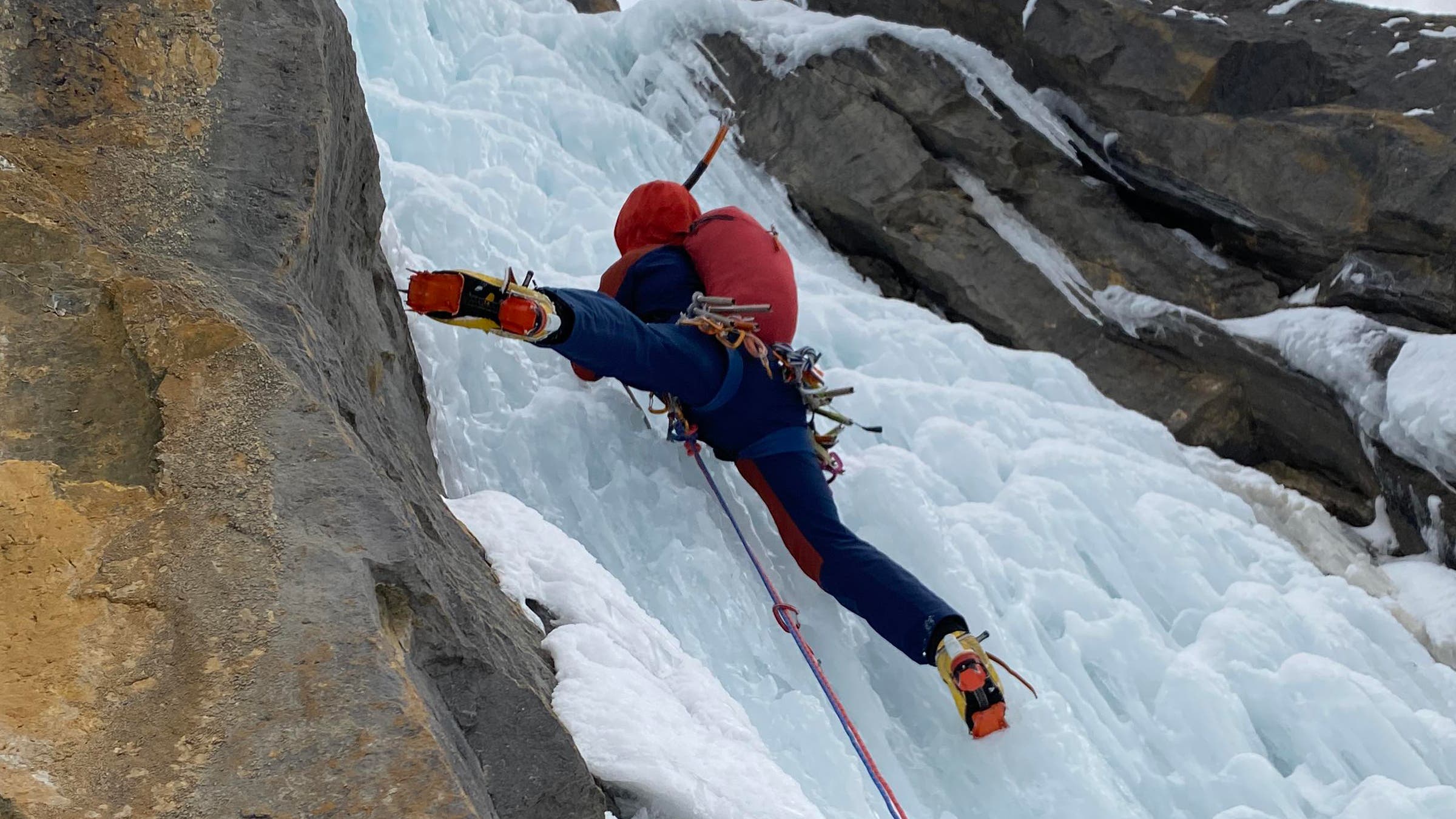
The author climbs Dirtbag Dreams (WI4+) in Banff National Park. Photo: Nolan Haas)
How we test climbing packs
Over the course of our extensive testing—which included clipping bolts at the Red River Gorge and Catalonia’s Siurana; swinging tools and sinking jams in the Bugaboos and Patagonia; multi-pitching in Red Rock, Washington Pass, and Squamish; and participating in the much-maligned “duffle shuffle” across the world—we scored each pack for its comfort, function, weight, durability, and price.
Our exact testing data, collected over five years in the field, is so vast that to put a number on it would surely be dismissed as hyperbole. But it’s safe to say we have hiked more than 1,000 miles in these backpacks, climbed tens of thousands of feet in them, and hauled hundreds of pitches. Our packs have been to the summits of Fitz Roy, Patagonia; North Howser Tower, Bugaboos; Liberty Bell, Washington Pass; and many more. Our 10-person testing team—comprised of women, men, and non-binary people—includes climbers of all ability levels and a range of body types, heights, and pack preferences.
Meet our testers
Anthony Walsh is a senior editor at Climbing Magazine. He enjoys long approaches, good granite, and frozen limestone. Aside from writing and editing narrative journalism, his favorite part of the job is testing gear.
Steven Potter was a digital editor at Climbing Magazine. He has been flailing on rocks since 2004, has successfully injured (and unsuccessfully rehabbed) nearly all of his fingers, and has had the pleasure of cragging at some of the world’s finest cliffs.
Emilie Grenier is a freelance writer and avid rock and ice climber. She is a self-described “trad dad” and seeks out gear designed for and by women.
More Gear Reviews
The Best Climbing Ropes for Rock, Ice, and the Gym
The Best Approach Shoes of 2025
The Best Climbing Helmets of the Year